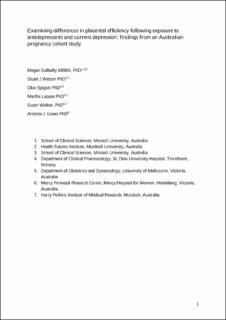| dc.contributor.author | Galbally, Megan | |
| dc.contributor.author | Watson, Stuart J. | |
| dc.contributor.author | Spigset, Olav | |
| dc.contributor.author | Lappas, Martha | |
| dc.contributor.author | Walker, Susan | |
| dc.contributor.author | Lewis, Andrew J. | |
| dc.date.accessioned | 2023-04-17T06:12:53Z | |
| dc.date.available | 2023-04-17T06:12:53Z | |
| dc.date.created | 2022-04-27T10:44:45Z | |
| dc.date.issued | 2022 | |
| dc.identifier.citation | Placenta. 2022, 119 44-51. | en_US |
| dc.identifier.issn | 0143-4004 | |
| dc.identifier.uri | https://hdl.handle.net/11250/3063222 | |
| dc.description.abstract | Introduction
Placental dysfunction and inefficiency, is important in understanding fetal growth restriction and low birth weight. Two recent studies have examined the relationship between antidepressant use in pregnancy and placental weight ratios; one found lower placental weight ratio associated with antidepressant use and the other found a higher ratio.
Methods
This study examined 342 women recruited in early pregnancy, including 75 taking antidepressants, 29 with current depression and 238 controls. Antidepressant use was measured through self-report in early and late pregnancy, hospital records at delivery and drug concentrations in umbilical cord and maternal blood obtained at delivery. Maternal depression was measured using the Structured Clinical Interview for the DSM IV (SCID) at recruitment. Placentas were collected at delivery and weighed, and infant birth weight recorded. Placental efficiency was measured using standardised placental weight residuals and included as the outcome in general linear models (ANOVA/ANCOVA) to test hypotheses.
Results
While placental weight was higher for those on antidepressants compared to controls (z=.30 c.f. Z=-0.08, p=.012), there were no significant differences between the three groups after adjusting for maternal body mass index at recruitment. When comparing antidepressant groups separately there were small-to-moderate positive associations between (SSRI) concentrations and placental weight (rho's > 0.20, p's > 0.05), which did not reach significance.
Conclusion
Antidepressant use in pregnancy was not associated with significant changes in placental efficiency after adjustment for confounding variables. Future research should expand on this to examine other aspects of placental function and include a wide range of potential confounding variables to draw clinically meaningful conclusions. | en_US |
| dc.language.iso | eng | en_US |
| dc.publisher | Elsevier | en_US |
| dc.rights | Attribution-NonCommercial-NoDerivatives 4.0 Internasjonal | * |
| dc.rights.uri | http://creativecommons.org/licenses/by-nc-nd/4.0/deed.no | * |
| dc.title | Examining differences in placental efficiency following exposure to antidepressants and current depression: Findings from an Australian pregnancy cohort study | en_US |
| dc.title.alternative | Examining differences in placental efficiency following exposure to antidepressants and current depression: Findings from an Australian pregnancy cohort study | en_US |
| dc.type | Peer reviewed | en_US |
| dc.type | Journal article | en_US |
| dc.description.version | acceptedVersion | en_US |
| dc.source.pagenumber | 44-51 | en_US |
| dc.source.volume | 119 | en_US |
| dc.source.journal | Placenta | en_US |
| dc.identifier.doi | 10.1016/j.placenta.2022.02.001 | |
| dc.identifier.cristin | 2019393 | |
| cristin.ispublished | true | |
| cristin.fulltext | postprint | |
| cristin.qualitycode | 2 | |

